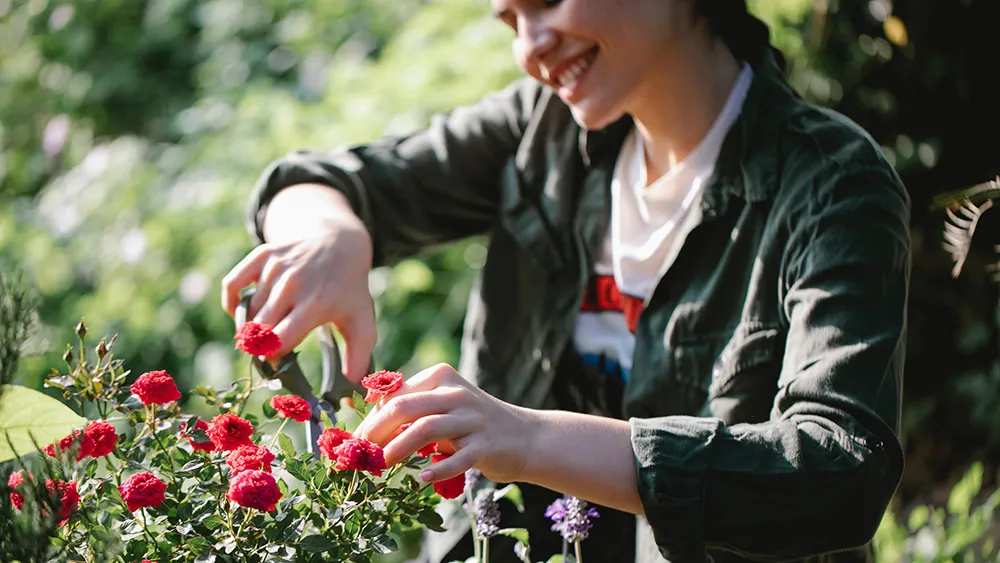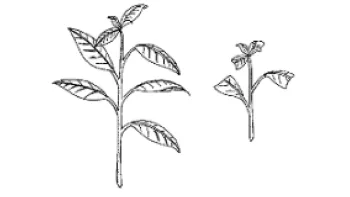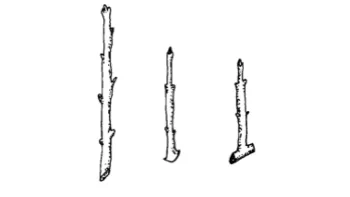Cuttings: Snip & Plant

Propagation through cuttings is the process of using a piece of an existing plant and encouraging it to grow into a new plant. Stems, leaves, and roots can all be used for cuttings. This is a good method for woody and herbaceous plants. Always take your cuttings from healthy and vigorous plants.
Equipment and materials:
Pruning/cutting tools. Always use clean, sharp cutting tools to make cuttings. Sanitize your cutting tool by dipping your cutting tool in a 10% bleach solution (one part bleach to nine parts water).
Containers. Wash small containers (4-inch diameter plastic pots work well) in soapy water and sanitize them in a 10% bleach solution (one part bleach to nine parts water).
Rooting medium. Use a mixture of sand, vermiculite, soil, and water or a mixture of peat, vermiculite, and perlite. The rooting medium must provide a light, airy mixture that allows water to flow through while retaining moisture.
Rooting hormone.
Protective environment. You can create a protective environment by covering containers with a plastic bag supported by chopsticks or covering a tray with clear plastic stretched over a wire frame.
Softwood stem cuttings

Softwood stem cuttings are probably the easiest and most common method. Take softwood stem cuttings from herbaceous (non-woody) plants such as Chrysanthemum and Dahlia. You can also take softwood cuttings from soft, succulent, new growth of woody deciduous or evergreen plants such as azaleas (Rhododendron) and Ceanothus in the spring.
1. Cut a two to six-inch piece of stem that includes the terminal bud. Make your cut at a slight angle one-quarter inch below a node. Your cutting should have several intact buds or leaves, and two to three nodes. (Nodes are the enlarged portions on stems from which leaves or buds grow.)
2. Remove flowers and flower buds so all the plant's energy goes into root formation.
3. Remove all lower leaves that might touch the rooting medium.
4. Dip cutting into a rooting hormone, covering at least one node.
5. Place in a container filled with a rooting medium.
6. Place in a protective moist environment with indirect light.
7. Tag your cuttings, identifying the date and the type of plant.
8. Water your cuttings and keep the rooting medium moist. Rooting should occur within two to five weeks.
Hardwood cuttings

Hardwood cuttings are taken from the wood of last season’s growth in late fall, winter, or early spring during the dormant period. The three types of hardwood cuttings are straight, mallet, and heel. A straight cutting is the most common. Use mallet and heel cuttings for plants that might otherwise be more difficult to root. For the heel cutting, a small section of older wood is included at the base of the cutting. For the mallet cutting, an entire section of older stem wood is included.
1. Cut a branch between 6 and 20 inches long and 1 to 2 inches in diameter.
2. Dip the end of each cutting in a rooting hormone, covering at least one node.
3. Bundle cuttings together and place in a plastic bag, filled with moist sawdust, or peat.
4. Tag cuttings, identifying the date and the type of plant.
5. Place cuttings in a dark cool area.
6. Mist cuttings to keep the sawdust or peat moist.
7. Check for rooting after four to six weeks.
8. Plant your cuttings outside after rooting occurs.
Leaf cuttings
Leaf cuttings are most commonly used for indoor plants including African violets (Saintpaulias) and Rex begonias (Begonia).
For African violets, use the entire leaf, leaf blade, or a portion of the leaf blade. Place the leaf cutting vertically in a rooting medium (perlite works well) after applying a rooting hormone. The new plant will form at the base of the leaf or at the midrib of a leaf blade.
For Rex begonias, which have split leaves, start with a mature leaf from your chosen plant. Cut its large veins in the lower leaf surface and place it lower side down on the rooting medium. The new plant should grow where the cut was made. Both types of leaf cuttings should be kept under moist conditions, and the new plant planted when it appears strong and vital.

